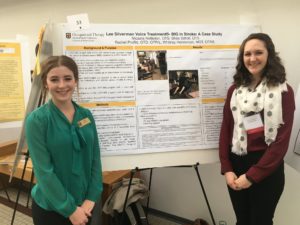Lee Silverman Voice Treatment (LSVT)®—BIG in Stroke: A Case Study
Funding: MU Department of Occupational Therap, LSVT® Global
LSVT®BIG is an intensive, movement intervention that utilizes amplitude-based feedback to impact the motor system. It has been shown to be effective in improving gait, balance, and upper extremity function in persons with Parkinson’s Disease. It has not been studied with people with chronic stroke. For this study, an individual 2 years post-stroke completed the protocol. The home exercise portion of the protocol was delivered via an engaging video game, Mystic Isle. The system uses the Microsoft Kinect® camera as the input device for the person’s movements and LSVT®BIG exercises are delivered in a virtual environment. The individual with stroke showed great improvements in performance and upper extremity motor function. Findings from this study have been presented at the Health Sciences Research Day, the American Congress of Rehabilitation Medicine Annual Conference, the American Occupational Therapy Association Annual Conference, and accepted for publication in the American Journal of Occupational Therapy.


Feasibility of the Lee Silverman Voice Treatment (LSVT)®- BIG in Stroke
Funding: American Occupational Therapy Foundation (AOTF) Intervention Research Grant
LSVT®BIG is an intensive, movement intervention that utilizes amplitude-based feedback to impact the motor system. It has been shown to be effective in improving gait, balance, and upper extremity function in persons with Parkinson’s Disease. The goal of this project was to evaluate the feasibility and acceptability of delivering the LSVT®BIG intervention for people post-stroke. Five individuals completed the program and demonstrated improvements in daily activities and quality of life. All individuals were able to complete the study visits and outcome measures as planned. Enrollment was challenging in rural Missouri. Future research will investigate the feasibility of delivering LSVT®BIG via telehealth for people post-stroke.
A virtual reality program to optimize adherence to home exercise programs in persons with chronic stroke
Funding: MU iCATS KL2, MU PCOR Small Project Award
Broadly, exercise and activity have proven beneficial in improving health after a stroke; however many people do not adhere to such programs and lack the motivation or knowledge to complete the exercises as prescribed. Virtual reality (VR) interventions have been heralded as a way to increase patient motivation in completing these exercises. This study seeks to determine the most effective combination of positive feedback in Mystic Isle and virtual coaching in improving adherence to a home exercise program for people with chronic stroke. This is done through a three-arm randomized pilot trial with a time-wise assessment of adherence and pre-post assessment of patient-centered outcomes (quality of life and occupational performance). The end-result of this study was the creation of an optimized intervention to be studied in a larger, pilot randomized clinical trial: Mystic Isle: Stroke.
Comparison of a markerless sensor to a gold-standard motion capture system for assessing function and performance in chronic stroke
Funding: MU Institute for Clinical and Translational Sciences (iCATS) KL2 Career Development Program
Stroke is the leading cause of serious, long-term disability in the United States. For many stroke survivors who do not experience a large degree of spontaneous recovery, home exercise programs are necessary. There are several barriers to these home programs including a lack of patient motivation and adherence to programs. Some of these barriers can be overcome through the use of interactive technologies and virtual reality (VR). Mystic Isle is customized rehabilitation software and utilizes a high-fidelity movement sensor, the Microsoft Kinect 2. The high level of customization in Mystic Isle allows occupational therapists to tailor treatment plans to individual clients and customize interventions through the specialized calibration settings and task-specification menus. Mystic Isle currently lacks an assessment tool to track patient progress and provide quantitative data to both the patient and therapist to monitor performance. The purpose of this study was to create and validate an assessment tool within Mystic Isle. Thirty five subjects played the Mystic Isle game. Data were simultaneously recorded by the Microsoft Kinect® and the Vicon motion capture system (gold standard). Data are still being processed and analyzed. Publications are planned for submission in 2017.
Novel Technologies as a Rehabilitation Intervention in Stroke
Funding: Mizzou Alumni Association Richard Wallace Faculty Incentive Grant
The purpose of this project was to determine the appropriate combination of newly available VR technologies and assess the feasibility and safety for use in the chronic stroke population. Five people with chronic stroke played a customized video game under two conditions: 1) using the Microsoft Kinect® camera as the input device and viewing the virtual environment and avatar on a TV monitor and 2) using the Microsoft Kinect® camera as the input device and viewing the virtual environment and avatar through the Oculus Rift® head mounted display. Results were positive and are under consideration for publication.